David McFall R.A. (1919 - 1988)
Sculptor
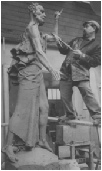
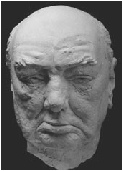
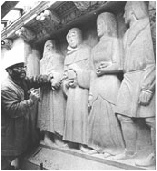
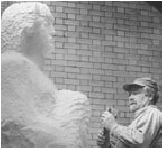

1959/4 Sir Winston S Churchill KG, OM, CH, MP - The Woodford Stat ue
ue
Height 8 feet 6"
Bronze (cast by Art Bronze foundry) on Cornish Granite plinth
The finished statue was unveiled at Salway Hill at the edge of Epping Forest in his constituency of Woodford on 31/10/1959 by Field Marshall Viscount Montgomery with Sir Winston Churchill and David McFall present among a large crowd of people.
References:
(i) The Sketch 10/9/1958 page 233 article by Louis T Stanley "Focus on Sculptors" describing "four of Britain's most famous sculptors" - McFall, Sir Charles Wheeler, Henry Moore and Sir William Dick: "The most arresting piece was the statue of Sir Winston Churchill ... standing 8 ft high it is a work of unusual strength with a mass of subtle detail in its making. A few hours earlier, I had listened to an Academician state that in his statue McFall had aimed consciously at ugliness. That is absurd... the basis of the Churchill likeness lies in the shape of the skull and in the bony structure of the face. It brings out his fierce, almost demonic energy."
(ii) New York Herald Tribune Paris 2/11/1959 in the report of the unveiling: "Churchill
likes statue – his parliamentary constituency were worried whether he would like
the statue unveiled yesterday. At the unveiling the old statesman climbed slowly
down from the speaker's stand and made a half circle to examine the bronze figure
from every angle. "Very nice" he said. And the crowd applauded, probably in relief,
for some critics had earlier described the statue as a baggy, bullet-headed gorilla.
What most of them did not know was that Sir Winston had also seen the early photographs
on which this condemnation was based and had made a few pungent but friendly suggestions
as a man w ho is not unversed in the arts himself. Sculptor David McFall did a quick
face-lifting job on his model and created a figure which, although obviously that
of an old man, gives a great impression of rugged power... "The photographs which
caused the hostility were taken too early" Mr McFall explained. "The people will
be proud of this statue."
ho is not unversed in the arts himself. Sculptor David McFall did a quick
face-lifting job on his model and created a figure which, although obviously that
of an old man, gives a great impression of rugged power... "The photographs which
caused the hostility were taken too early" Mr McFall explained. "The people will
be proud of this statue."
(iii) Evening Standard 22/4/1974 page 11 with photograph
iv) letter to The Times 24/1/1959 from Sir Stuart Mallinson Trustee of the WSC Commemoration
Fund: "...photographs [of the statue in progress] have been adversely criticised...
these photographs were taken of an unfinished statue in t he first stage of sculpture
- clay.... the stage photographed in no way represents the final effect in bronze.
It must be remembered that they were taken of an 8'6" statue in a small studio where
it was impossible for the photographer to get any distance from it...The sponsors
feel that while it would have been possible to produce a statue of Sir Winston in
his more cherubic aspect, this statue will convey what they wished - the Prime Minister
whose voice held the nation together, brought hope to those in darkness, and defied
the power of Hitler; and in the opinion of many who have seen it even at this stage,
this work of Mr David McFall is a masterpiece."
he first stage of sculpture
- clay.... the stage photographed in no way represents the final effect in bronze.
It must be remembered that they were taken of an 8'6" statue in a small studio where
it was impossible for the photographer to get any distance from it...The sponsors
feel that while it would have been possible to produce a statue of Sir Winston in
his more cherubic aspect, this statue will convey what they wished - the Prime Minister
whose voice held the nation together, brought hope to those in darkness, and defied
the power of Hitler; and in the opinion of many who have seen it even at this stage,
this work of Mr David McFall is a masterpiece."
(v) letter from Lady Churchill (Chartwell): 13/12/1958 Dear Mr McFall, I tried unsuccessfully to reach you on the telephone this morning, as I wanted to have a talk with you about the statue. I think it is a remarkable achievement; but I am disturbed at what to me, seems an exaggeration - indeed (almost - crossed out) a caricature of Winston. Here are two photographs taken during the war period. In both we have the projecting lower lip, but not swollen as it appears to be in the statue. I think he looks quite fierce enough in photograph No. 2 ! I have lived with him now for fifty years and I can never remember him looking in the least like the ferocious representation, say in Mr Karsh's famous photograph. The angry, indignant expression was obtained by Mr Karsh snatching my Husband's cigar from his mouth, and immediately registering his furious expression, but this is a manufactured expression and not his natural one. I am afraid it is too late for anything to be done ? But I think angry and brutal expressions are particularly out of place because during the War whenever there was a bad crisis, my husband was always calm and serene. Please forgive me. But I do feel just a touch might make the statue live.
[BUT SEE from "The Brabazon Story" autobiography of Lord Brabazon of Tara G.B.E., M.C., P.C.: "...There was a series of meetings during the war that I can never erase from my memory ... in my opinion they were the most unpleasant meetings I ever attended. The issue was grave, but the way Churchill treated everyone was almost unbearable. He usually appeared after his early afternoon sleep in the vilest of tempers, and having such a problem to face did not improve it. He behaved as if he were a bullying schoolmaster. Everyone, in his opinion, was a halfwit; and if anyone said anything he was jumped on and snubbed. His chief butt was Sir Archibald Sinclair, Secretary of State for Air, one of his cabinet colleagues. The abuse and insults Winston heaped upon him were unbelievable ... I know how the situation affected the Prime Minister, but the general cursing everyone was not the best way of inspiring incentive and imagination towards a solution of the problem. I am not an admirer of Sutherland's painting of Churchill - nor do I like those of Maugham or Beaverbrook - but I do say with little fear of contradiction that his portrait exactly portrays the man as he appeared to the committee whose unfortunate duty it was to attend."
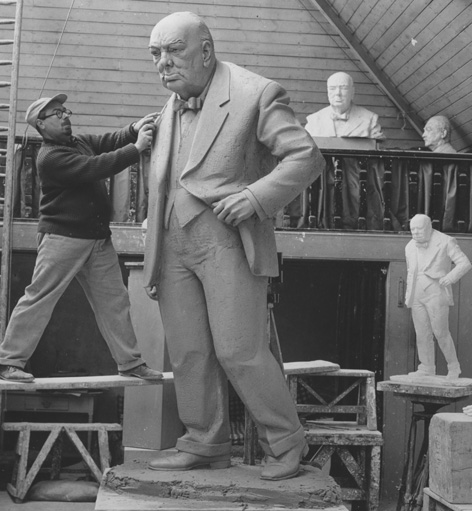
(vi) letter from McFall to Daily Telegraph 16/1/78: "As the last artist to work from Sir Winston perhaps you will permit me a few recollections ...Lady Churchill was the perfect hostess ... But on the subject of portraits of Sir Winston she became transported into a screaming dervish. Conducting me around the gallery of "acceptable" portraits at Chartwell, "not one has had a single sitting" she declared. She announced that "the Sutherland picture would never be seen again", that she had seen to it - adding, to my consternation, that "accidents could happen to sculpture as well ..." Subsequently my Woodford statue was wrenched and cracked by a steel hawser winched to a lorry whose wheels gouged into the mud ... However, Sir Winston refused to budge, embedded as he is in five tons of Cornish granite ! It is an interesting comparison to note that in one respect the portrait sculptor has an advantage over the painter in that the sitter can watch the sculptor's progress as he works. Whereas, in the case of the Sutherland portrait, the finished canvas came as a considerable shock seen for the first time. But the sculptor must have the concentration to dismiss the sitter's advice as the work proceeds. Sir Winston repeatedly demonstrated with the flat of his hand what he believed to be the exceptional height of his forehead..."Observe" he would say, "that my forehead measures exactly half my head". Epstein told me that Churchill had made the same observation to him, but Sir Jacob mischievously pointed out that we all look lofty as seen in the shaving mirror... More poignantly, Sir Winston asked Epstein to leave out "all that scraggy skin under my chin". I well remember that he did so, because I cast his original clay model immediately after the third sitting. If it is any consolation to Mr Sutherland, I thought that his finished canvas had the same fault as my statue, that is to the point of being laboured and strained."
(vii) The bronze statue to Sir Winston Churchill is a prominent landmark on Woodford Green, overlooking the top of Salway Hill. It was commissioned from sculptor David McFall and unveiled in 1959 to celebrate the great war-time leader's time as MP for Wanstead and Woodford.
IMMORTALISED in bronze, the figure of Britain’s formidable wartime leader still casts
a giant shadow over Woodford Green more than 40 years after his death. His statue,
which glares moodily towards South Woodford from the top of Salway Hill, serves as
a fitting reminder of his legacy as Prime Minister during the Second World War, and
as the area’s most famous MP. Churchill was in the twilight of his political career
when he became MP for Woodford in 1945, his greatest achievements already behind
him. A self-confessed workaholic, he continued to represent the constituency right
up to October 1964, just months before his death at the age of 90. Churchill’s election
came on the back of a devastating defeat for the Conservative Party during the first
post-war general election, but he remained a popular figure in Redbridge, and it
was not long before a fund was set-up to raise money to build a permanent monument.
Sculptor David McFall finally completed the statue in 1959, and it was immediately
adopted by Wanstead and Woodford Council to be held in trust for the people of the
area. More than 5,000 people flocked to the green to watch the grand unveiling, with
famous Second World War general, Field Marshall Viscount Montgomery, on hand to praise
his friend’s work. He told the assembled crowd: “This famous man to whom this statue
is designed is still most happily with us, enjoying in dignity and quiet the evening
of his splendid life. “But that, alas, will not always be so. Future generations
will not only need, but will desire to know what he looked like, and it is most fitting
that you in Woodford have decided to supply the answer. “He has received your unfailing
loyalty for more than a quarter of a century. Woodford was his political Alamein.”
Churchill, then an ailing 85 year-old, told his adoring audience: “I am most grateful
to the people of Wanstead and Woodford for the signal honour you now do me. “It has
been a privilege representing you in Parliament.” But while the ceremony went without
a hitch, it was soon decided to place the statue under 24-hour police guard for the
following few weeks, for fear it would be targeted by vandals and practical jokers.
Except for occasional bird droppings and the odd piece of graffiti, the statue has
remained relatively unmolested ever since. While the man himself is gone, his statue
will maintain a watchful eye for many years to come. [Daniel Binns]
reminder of his legacy as Prime Minister during the Second World War, and
as the area’s most famous MP. Churchill was in the twilight of his political career
when he became MP for Woodford in 1945, his greatest achievements already behind
him. A self-confessed workaholic, he continued to represent the constituency right
up to October 1964, just months before his death at the age of 90. Churchill’s election
came on the back of a devastating defeat for the Conservative Party during the first
post-war general election, but he remained a popular figure in Redbridge, and it
was not long before a fund was set-up to raise money to build a permanent monument.
Sculptor David McFall finally completed the statue in 1959, and it was immediately
adopted by Wanstead and Woodford Council to be held in trust for the people of the
area. More than 5,000 people flocked to the green to watch the grand unveiling, with
famous Second World War general, Field Marshall Viscount Montgomery, on hand to praise
his friend’s work. He told the assembled crowd: “This famous man to whom this statue
is designed is still most happily with us, enjoying in dignity and quiet the evening
of his splendid life. “But that, alas, will not always be so. Future generations
will not only need, but will desire to know what he looked like, and it is most fitting
that you in Woodford have decided to supply the answer. “He has received your unfailing
loyalty for more than a quarter of a century. Woodford was his political Alamein.”
Churchill, then an ailing 85 year-old, told his adoring audience: “I am most grateful
to the people of Wanstead and Woodford for the signal honour you now do me. “It has
been a privilege representing you in Parliament.” But while the ceremony went without
a hitch, it was soon decided to place the statue under 24-hour police guard for the
following few weeks, for fear it would be targeted by vandals and practical jokers.
Except for occasional bird droppings and the odd piece of graffiti, the statue has
remained relatively unmolested ever since. While the man himself is gone, his statue
will maintain a watchful eye for many years to come. [Daniel Binns]
All rights reserved

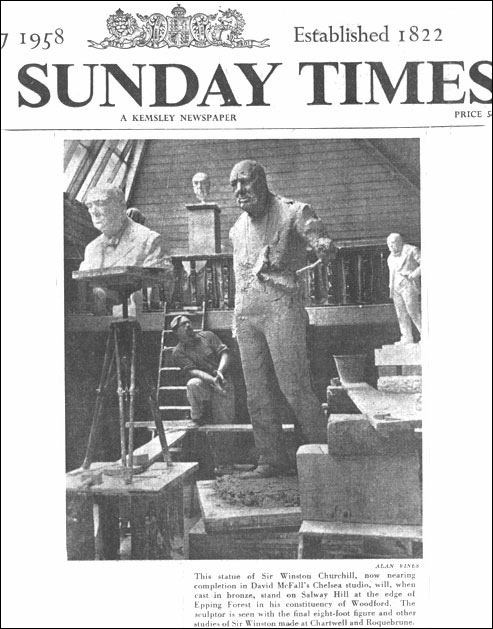


| Animals |
| Busts and Heads |
| Children |
| Churchill studies |
| Lettering |
| Medals coins plates |
| Reliefs |
| Stone carvings |
| Contemporary British Artists |
| On Epstein |
| Picasso |
| The art of portrait sculpture |
| Letters |
| Palliser |
| Son of Man |
| Press |
| Obituaries |
| Memorial address |